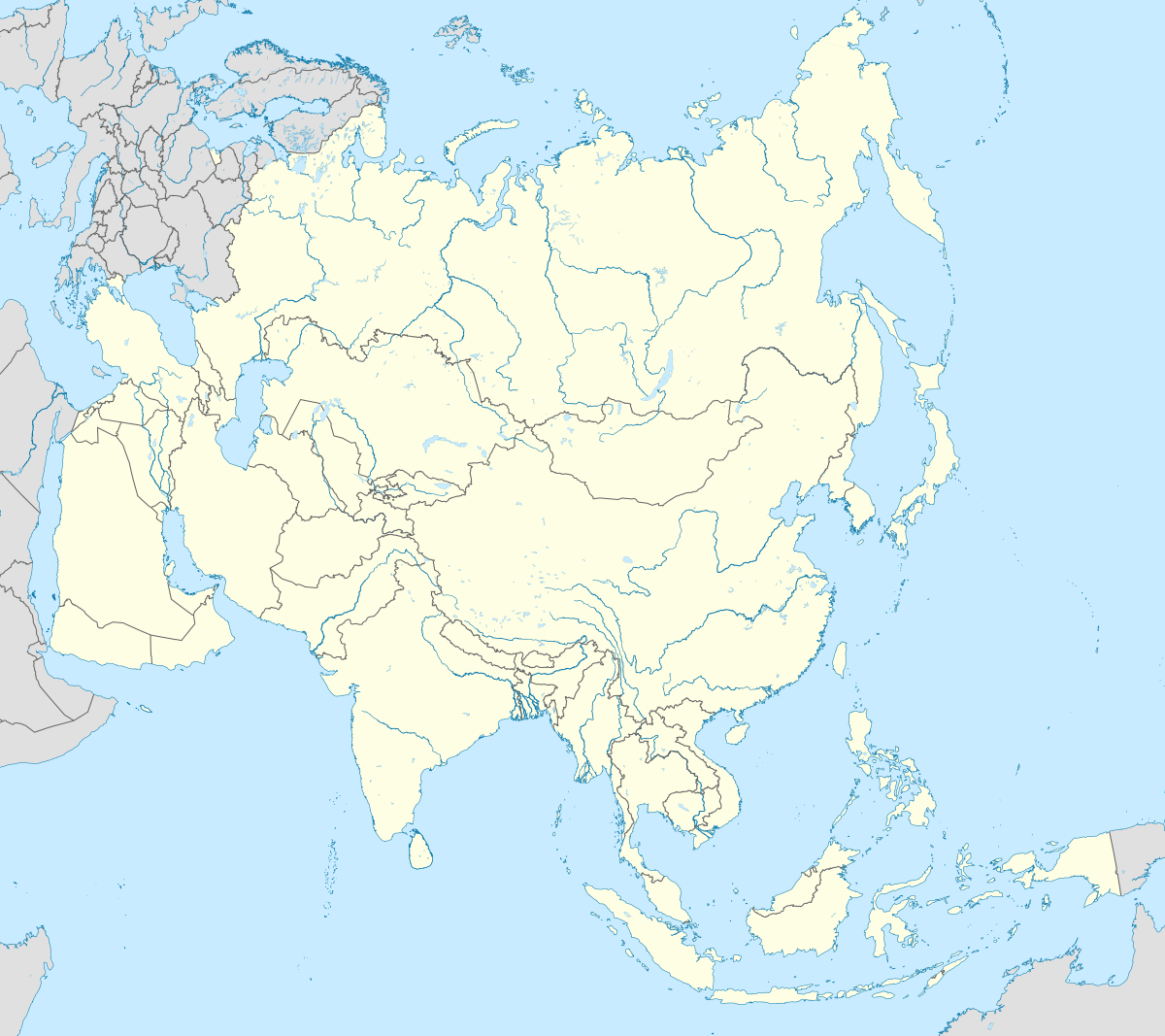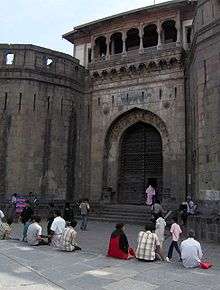Pune
Pune, also known as Poona (Marathi: [puɳe] (![]()
Pune | |
|---|---|
 Top to bottom, left to right: Pune Skyline, Sam Manekshaw Statue in Pune Camp, Shaniwarwada, Fergusson College, and Baji Rao I Statue outside Shaniwarwada | |
| Nickname(s): | |
| Coordinates: 18°31′13″N 73°51′24″E | |
| Country | |
| State | Maharashtra |
| District | Pune |
| Established | 17th Century[3] |
| Government | |
| • Type | Municipal Corporation |
| • Body | Pune Municipal Corporation |
| • Municipal Commissioner | Vikram Kumar, IAS[4][5] |
| • Mayor | Murlidhar Mohol (BJP)[6] |
| Area | |
| • PMC | 331.26 km2 (127.90 sq mi) |
| • Metro[9][10] | 7,256.4 km2 (2,801.7 sq mi) |
| Elevation | 560 m (1,840 ft) |
| Population (2011)[11] | |
| • PMC | 3,124,458 |
| • Rank | 8th |
| • Density | 9,400/km2 (24,000/sq mi) |
| • metro | 7,276,000[9] |
| • Metro Rank | 8th |
| Demonym(s) | Punekar,[12] Poonaite[13] |
| Time zone | UTC+5:30 (IST) |
| PIN Code(s) | 411001 – 411062[14] |
| Area code(s) | +91-20 |
| Vehicle registration | MH 12 |
| Member of Parliament | Girish Bapat (BJP)[15][16] |
| Official language | Marathi |
| Website | pmc |
Along with its extended city limits Pimpri Chinchwad and the three cantonment towns of Pune, Khadki and Dehu Road, Pune forms the urban core of the eponymous Pune Metropolitan Region (PMR).[24] According to the 2011 census, the urban area has a combined population of 5.05 million while the population of the metropolitan region is estimated at 7.4 million.[9] Situated 560 metres (1,837 feet) above sea level on the Deccan plateau on the right bank of the Mutha river,[25] Pune is also the administrative headquarters of its namesake district. In the 18th century, the city was the seat of the Peshwas, the prime ministers of the Maratha Empire and was one of the most important political centres on the Indian subcontinent.[26]
Pune is widely regarded as the second major "IT hub of India"[27][28] and the top "automobile and manufacturing hub of India".[29] It is also known as the "Oxford of the East" due to the presence of several well-known educational institutions.[30][31] India's first indigenously-run girls' school was started in Pune by Savitribai Phule along with her associate Fatima Sheikh.[32] The city has emerged as a major educational hub in recent decades, with nearly half of the total international students in the country studying in Pune.[33][34] Research institutes of information technology, education, management and training attract students and professionals from India and overseas.
Etymology
The earliest reference to Poona is an inscription on a Rashtrakuta Dynasty copper plate dated 937 CE, which refers to the town as Punya-Vishaya, meaning "sacred news".[35] By the 13th century, it had come to be known as Punawadi.[36]
During the Rashtrakuta dynasty, the city was referred to as “Punnaka“ and Punyapur“, while the copper plates of 758 AD and 768 AD show that the Yadava dynasty had renamed it as “Punakavishaya“ and “Punya Vishaya“. “Vishaya“ means land and “Punaka“ and “Punya“ mean holy. The city was known as “Kasbe Pune“ when in the command of Shivaji's father, Shahaji Raje Bhosale. It became “Poona“ in the British regime in 1857 and was last changed to Pune in 1978. The only exception was when Mughal emperor Aurangzeb renamed the city as “Muhiyabad“ sometime between 1703 and 1705 in memory of his great-grandson Muhi-ul-Milan, who died here. But the name got erased soon after Aurangzeb's death.[37]
History
Early and medieval period

Copper plates dated 858 and 868 CE show that by the 9th century an agricultural settlement known as Punnaka existed at the location of the modern Pune. The plates indicate that this region was ruled by the Rashtrakuta dynasty. The Pataleshwar rock-cut temple complex was built during this era.[38] Pune was part of the territory ruled by the Seuna Yadavas of Devagiri from the 9th century to 1327.
Bhosale Jagir and the Maratha Empire
Pune was part of the Jagir (fiefdom) granted to Maloji Bhosale in 1599 for his services to the Nizamshahi (Ahmadnagar Sultanate).[39] Pune was ruled by the Ahmadnagar Sultanate until it was annexed by the Mughals in the 17th century. Maloji Bhosale's grandson, Shivaji, the founder of the Maratha Empire, was born at Shivneri, a fort not far from Pune.[40] It changed hands several times between the Mughals and the Marathas in the period 1680 to 1705.
After the destruction of the town in raids by the Adil Shahi dynasty in 1630 and again between 1636 and 1647, Dadoji Konddeo, the successor to Dhadphale, oversaw the reconstruction of the town. He stabilised the revenue collection and administrative systems of the areas around Pune and the neighbouring Maval region. He also developed effective methods to manage disputes and to enforce law and order.[41] The Lal Mahal was commissioned in 1631 and construction was completed in 1640 AD.[35] Shivaji spent his young years at the Lal Mahal. His mother, Jijabai is said to have commissioned the building of the Kasba Ganapati temple. The Ganesha idol consecrated at this temple has been regarded as the presiding deity (Gramadevata) of the city.[42]
From 1703 to 1705, towards the end of the 27-year-long Mughal–Maratha Wars, the town was occupied by Aurangzeb and its name was changed to Muhiyabad.[20][43] Two years later in the Battle of Sinhagad, the Marathas recaptured Sinhagad fort, and later Pune, from the Mughals.
Peshwa rule
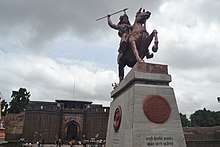
In 1720, Baji Rao I was appointed Peshwa (prime minister) of the Maratha Empire by ShahuI.[46] He moved his base from Saswad to Pune in 1728, marking the beginning of the transformation of what was a kasbah into a large city.[47][48] He also commissioned the construction of the Shaniwar Wada on the right bank of the Mutha River. The construction was completed in 1730, ushering in the era of Peshwa control of the city. Bajirao's son and successor, Nanasaheb constructed a lake at Katraj on the outskirts of the city and an underground aqueduct to bring water from the lake to Shaniwar Wada and the city.[49][50] The aqueduct was still in working order in 2004.[51]
The patronage of the Maratha Peshwas resulted in a great expansion of Pune, with the construction of around 250 temples and bridges in the city, including the Lakdi Pul and the temples on Parvati Hill[52] and many Maruti, Vithoba, Vishnu, Mahadeo, Rama, Krishna and Ganesh temples. The building of temples led to religion being responsible for about 15% of the city's economy during this period.[48][53] Pune prospered as a city during the reign of Nanasaheb Peshwa. He developed Saras Baug, Heera Baug, Parvati Hill and new commercial, trading, and residential localities. Sadashiv Peth, Narayan Peth, Rasta Peth and Nana Peth were developed. The Peshwa's influence in India declined after the defeat of Maratha forces at the Battle of Panipat but Pune remained the seat of power. In 1802 Pune was captured by Yashwantrao Holkar in the Battle of Poona, directly precipitating the Second Anglo-Maratha War of 1803–1805. The Peshwa rule ended with the defeat of Peshwa Bajirao II by the British East India Company in 1818.[54]
Historian Govind Sakharam Sardesai lists 163 prominent families that held high ranks and played significant roles in politics, military and finance in 18th century Pune. Of these 163 families, a majority(80) were Deshastha Brahmins, 46 were Chitpawan, 15 were Chandraseniya Kayastha Prabhu(CKP) whereas Karhade Brahmin and Saraswat accounted for 11 families each.[55]
British rule (1818–1947)
The Third Anglo-Maratha War broke out between the Marathas and the British East India Company in 1817. The Peshwas were defeated at the Battle of Khadki (then spelled Kirkee) on 5 November near Pune and the city was seized by the British. It was placed under the administration of the Bombay Presidency and the British built a large military cantonment to the east of the city (now used by the Indian Army). The Southern Command of the Indian Army was established in 1895 and has its headquarters in Pune cantonment.[56][57][58]
The city of Pune was known as Poona during British rule. Poona Municipality was established in 1858. A railway line from Bombay to the city opened in 1858, run by the Great Indian Peninsula Railway (GIPR).[59][60] Navi Peth, Ganj Peth (now renamed Mahatma Phule Peth) were developed during the British Raj.
Centre of social reform and nationalism

Pune was prominently associated with the struggle for Indian independence. In the period between 1875 and 1910, the city was a centre of agitation led by Gopal Krishna Gokhale and Bal Gangadhar Tilak. The city was also a centre for social reform led by Gopal Ganesh Agarkar, Mahatma Jyotirao Phule, feminist Tarabai Shinde, Dhondo Keshav Karve and Pandita Ramabai. They demanded the abolition of caste prejudice, equal rights for women, harmony between the Hindu and Muslim communities, and better schools for the poor.[61] Mahatma Gandhi was imprisoned at the Yerwada Central Jail several times and placed under house arrest at the Aga Khan Palace between 1942 and 1944, where both his wife Kasturba Gandhi and aide Mahadev Desai died.[62]
Pune since Indian independence
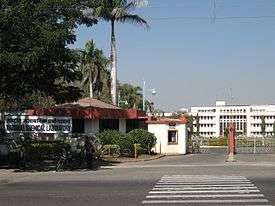
After Indian independence from the British in 1947, Pune saw enormous growth transforming it into a modern metropolis. The Poona Municipal Council was reorganised to form the Pune Municipal Corporation (PMC) in 1950.[63] The education sector in the city continued its growth in the post-independence era with the establishment of the University of Pune (now, Savitribai Phule Pune University) in 1949, the National Chemical Laboratory in 1950 and the National Defence Academy in 1955.[64][65][66]
The establishment of Hindustan Antibiotics in 1954 marked the beginning of industrial development in the Hadapsar, Bhosari, and Pimpri areas.[67][68] MIDC provided the necessary infrastructure for new businesses to set up operations.[69] In the 1970s, several engineering companies were set up in the city, allowing it to vie with Chennai.[70][71] In the 1990s, Pune began to attract foreign capital, particularly in the information technology and engineering industries. IT parks were established in Aundh, Viman Nagar, Hinjawadi, Wagholi, Kharadi and Balewadi-Baner region. As a result, the city saw a huge influx of people to the city due to opportunities offered by the manufacturing, and lately, the software industries.
The breach in the Panshet dam and the resulting flood of 1961 led to severe damage and destruction of housing close to the river banks.[72] The mishap spurred the development of new suburbs and housing complexes.[73] To integrate urban planning, the Pune Metropolitan Region was defined in 1967 covering the area under PMC, the Pimpri-Chinchwad Municipal Corporation, the three cantonments and the surrounding villages.[74]
In 1998 work on the six-lane Mumbai-Pune expressway began; it was completed in 2001.[75] In 2008 the Commonwealth Youth Games took place in Pune, which encouraged development in the northwest region of the city.[76] On 13 February 2010 a bomb exploded at the German Bakery in the upmarket Koregaon Park neighbourhood in eastern Pune, killing 17 and injuring 60.[77][78][79] Evidence suggested that the Indian Mujahideen terrorist group carried out the attack.[80]
Geography
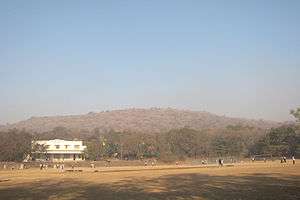
Pune is situated at approximately 18° 32" north latitude and 73° 51" east longitude. The city's total area is 15.642 sq. km.[81] By road Pune is 1,173 km (729 mi) south of Delhi, 734 km (456 mi) north of Bangalore, 570 km (350 mi) north-west of Hyderabad and 149 km (93 mi) south-east of Mumbai.
Pune lies on the western margin of the Deccan plateau, at an altitude of 560 m (1,840 ft) above sea level. It is on the leeward side of the Sahyadri mountain range, which forms a barrier from the Arabian Sea. It is a hilly city, with Vetal Hill rising to 800 m (2,600 ft) above sea level. The Sinhagad fort is at an altitude of 1,300 metres (4,300 feet).
The old city of Pune is at the confluence of the Mula and Mutha rivers. The Pavana, a tributary of Mula river and Indrayani river, a tributary of the Bhima river, traverse the northwest suburbs of Pune.
Cityscape
The modern city of Pune has many distinct neighbourhoods. These include the numerous peths of the old city on the eastern bank of the Mutha river, the cantonment areas of Khadki and Pune Camp established by the British, and numerous suburbs.[68] The industrial growth in the Pimpri, Chinchwad and nearby areas allowed these areas to incorporate as the separate city of Pimpri-Chinchwad.[69][82][83][84][85][86][87]
The Pune Metropolitan Region (PMR), initially defined in 1967, has grown to 7,256 km2 made up of the ten talukas of the Pune district.[88] The twin cities of Pune and Pimpri-Chinchwad along with the three cantonment areas of Pune, Khadki and Dehu Road form the urban core of the PMR, which also includes seven municipal councils and 842 villages.[88][89][90]
Rapid industrialisation since the 1960s has led to large influx of people to the city. Housing supply has not kept pace with demand, causing the number of slum dwellings to increase.[91] Approximately 36% of the population lives in 486 slum areas. Of these, 45% slum households do not have in-house toilet facilities and 10% do not have electricity. One third of the slums are on mixed ownership land. The living conditions in slums varies considerably, depending on their status (formal/informal) and in how far non-governmental organisations (NGOs), community organisations (CBOs) and government agencies are involved and committed to improving local living conditions.[92]
Since the 1990s a number of landmark integrated townships and gated communities have been developed in Pune such as Magarpatta, Nanded city, Amanora, Blue Ridge, Life Republic and Lavasa.[93] They also offer business opportunities and access to infrastructure. According to the PMC, six townships with up to 15,000 housing units existed in Pune in 2012 and 25 more were in the planning process.[92]
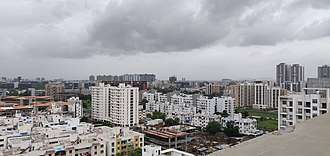
The Mercer 2017 Quality of Living Rankings evaluated living conditions in more than 440 cities around the world and ranked Pune at 145, second highest in India after Hyderabad at 144.[94] The same source highlights Pune as being among evolving business centres and as one of nine emerging cities around the world with the citation "Hosts IT and automotive companies".[95] The 2017 Annual Survey of India's City-Systems (ASICS) report, released by the Janaagraha Centre for Citizenship and Democracy, adjudged Pune as the best governed of 23 major cities.[96]
Peths in Pune
Peth is a general term in the Marathi language for a locality in Pune. Seventeen peths are located in Pune, which today constitute the old city of Pune. Most were established during the Maratha empire era under the Maratha and Peshwa rule of the city in the 18th century, before the arrival of the British.[97] Seven of them are named after the days of the week in Marathi, and the day of the week on which traders and craftsmen in these peths mainly conducted business corresponded to the day after which each is named. Other peths are named after their respective founders. Pune includes seventeen peths: Ghorpade Peth, Somwar Peth, Mangalwar Peth, Budhwar Peth, Guruwar Peth, Shukrawar Peth, Shaniwar Peth, Raviwar Peth, Kasba Peth, Bhawani Peth, Ganj Peth, Nana Peth, Ganesh Peth, Sadashiv Peth, Narayan Peth, Rasta Peth, Navi Peth.
Climate
Pune has a hot semi-arid climate (type BSh) bordering with tropical wet and dry (type Aw) with average temperatures ranging between 20 and 28 °C (68 and 82 °F).[98] Pune experiences three seasons: summer, monsoon, and winter. Typical summer months are from mid-March to mid-June, with maximum temperatures sometimes reaching 42 °C (108 °F). The warmest month in Pune is May. The city often has heavy dusty winds in May, with humidity remaining high. Even during the hottest months, the nights are usually cool due to Pune's high altitude. The highest temperature recorded was 43.3 °C (109.9 °F) on 30 April 1897.[99]
The monsoon lasts from June to October, with moderate rainfall and temperatures ranging from 22 to 28 °C (72 to 82 °F). Most of the 722 mm (28.43 in) of annual rainfall in the city falls between June and September, and July is the wettest month of the year. Hailstorms are not unheard of.
For most of December and January the daytime temperature hovers around 26 °C (79 °F) while night temperatures are below 9 °C (48 °F), often dropping to 5 to 6 °C (41 to 43 °F). The lowest temperature recorded was 1.7 °C (35 °F) on 17 January 1935.
| Climate data for Pune (1981–2010, extremes 1901–2012) | |||||||||||||
|---|---|---|---|---|---|---|---|---|---|---|---|---|---|
| Month | Jan | Feb | Mar | Apr | May | Jun | Jul | Aug | Sep | Oct | Nov | Dec | Year |
| Record high °C (°F) | 35.3 (95.5) |
38.9 (102.0) |
42.8 (109.0) |
43.3 (109.9) |
43.3 (109.9) |
41.7 (107.1) |
36.0 (96.8) |
35.0 (95.0) |
36.1 (97.0) |
37.8 (100.0) |
36.1 (97.0) |
35.0 (95.0) |
43.3 (109.9) |
| Average high °C (°F) | 29.8 (85.6) |
32.1 (89.8) |
35.6 (96.1) |
37.6 (99.7) |
36.9 (98.4) |
31.9 (89.4) |
28.3 (82.9) |
27.6 (81.7) |
29.4 (84.9) |
31.5 (88.7) |
30.4 (86.7) |
29.2 (84.6) |
31.7 (89.1) |
| Average low °C (°F) | 11.2 (52.2) |
12.2 (54.0) |
15.7 (60.3) |
19.6 (67.3) |
22.6 (72.7) |
23.1 (73.6) |
22.4 (72.3) |
21.7 (71.1) |
20.9 (69.6) |
18.4 (65.1) |
14.5 (58.1) |
11.5 (52.7) |
17.8 (64.0) |
| Record low °C (°F) | 1.7 (35.1) |
3.9 (39.0) |
7.2 (45.0) |
10.6 (51.1) |
13.8 (56.8) |
17.0 (62.6) |
18.9 (66.0) |
17.2 (63.0) |
13.2 (55.8) |
9.4 (48.9) |
4.6 (40.3) |
3.3 (37.9) |
1.7 (35.1) |
| Average rainfall mm (inches) | 1.1 (0.04) |
0.3 (0.01) |
2.2 (0.09) |
8.5 (0.33) |
26.8 (1.06) |
173.4 (6.83) |
181.4 (7.14) |
145.2 (5.72) |
146.1 (5.75) |
86.3 (3.40) |
25.0 (0.98) |
7.0 (0.28) |
803.0 (31.61) |
| Average rainy days | 0.2 | 0.1 | 0.2 | 0.8 | 1.9 | 9.5 | 12.4 | 9.8 | 8.0 | 4.4 | 1.2 | 0.3 | 48.7 |
| Average relative humidity (%) (at 17:30 IST) | 34 | 26 | 21 | 24 | 37 | 66 | 76 | 79 | 73 | 53 | 43 | 39 | 47 |
| Mean monthly sunshine hours | 294.5 | 282.5 | 300.7 | 303.0 | 313.1 | 183.0 | 114.7 | 111.6 | 177.0 | 244.9 | 264.0 | 279.0 | 2,868 |
| Mean daily sunshine hours | 9.5 | 10.0 | 9.7 | 10.1 | 10.1 | 6.1 | 3.7 | 3.6 | 5.9 | 7.9 | 8.8 | 9.0 | 7.9 |
| Source: India Meteorological Department[100][101][102] | |||||||||||||
Seismology
Pune is 100 km (62 mi) north of the seismically active zone around Koyna Dam.[103][104] The India Meteorological Department has assessed this area as being in Zone 3, on a scale of 2 to 5, with 5 being the most prone to earthquakes.[105][106] Pune has experienced some moderate – and many low – intensity earthquakes in its history.
Demographics
| Pune population | |||
|---|---|---|---|
| Census | Population | %± | |
| 1901 | 153,320 | — | |
| 1951 | 488,419 | — | |
| 1971 | 856,105 | — | |
| 1981 | 1,203,351 | 40.6% | |
| 1991 | 1,566,651 | 30.2% | |
| 2001 | 2,540,069 | 62.1% | |
| 2011 | 3,124,458 | 23.0% | |
| Source: Census of India | |||
The city has a population of 3,124,458; while 5,057,709 people reside in the Pune Urban Agglomeration as of the 2011 census.[107] The latter was c. 4,485,000 in 2005. According to the Pune Municipal Corporation (PMC), 40% of the population lived in slums in 2001.[108]
Since Pune is a major industrial metropolis, it has attracted migrants from all parts of India. The number of people migrating to Pune rose from 43,900 in 2001 to 88,200 in 2005.[109] The sharp increase in population during the decade 1991–2001 led to the absorption of 38 fringe villages into the city.[110] The top five source areas of migrants are Karnataka, Uttar Pradesh, Andhra Pradesh, Gujarat, and Rajasthan. The Sindhis in the city are mostly refugees and their descendants, who came to the area after the partition of India in 1947.[111] Initially they settled in the Pimpri area, which is still home to a large number of Sindhi people. However, they are also present in other parts of the city.[112] As agriculture has dwindled in recent decades, immigration of the erstwhile rural peoples now accounts for 70 percent of the population growth.[113][114]
Marathi is the official and most spoken language. The average literacy rate of Pune was 86.15% in 2011 compared to 80.45% in 2001.[115]
Religion
Hinduism is the dominant religion in Pune. Other religions with a significant presence include Islam, Buddhism, Jainism, Christianity and Zoroastrianism.[116]
Of the many Hindu temples in the city, the Parvati temple complex on Parvati Hill and at least 250 others date back to the 18th century.[117] These temples were commissioned by the Peshwas, who ruled the city at the time, and are dedicated to various deities including Maruti, Vithoba, Vishnu, Mahadeo, Rama, Krishna and Ganesh.[118][119][120][121] The historic temples of Kasba Ganapati, the Tambadi (Red) Jogeshwari are considered the guardian deities of the city.[122][123]Dagdusheth Halwai Ganapati Temple is the richest Ganesh temple in Pune. Pune has two of the most important pilgrimage centres of the Varkari sect of the Bhakti movement in Maharashtra, namely Alandi where the samadhi of 13th century Saint Dnyaneshwar is located and Dehu where the 17th century Saint Tukaram lived. Every year in the Hindu month of Ashadh (June/July), the Paduka (symbolic sandals) of these saints are carried in a pilgrimage, the Pandharpur Vari, to meet Vithoba. The procession makes a stopover in the city on its way to Pandharpur attracting hundreds of thousands of Varkaris and devotees. Other important Hindu pilgrimage sites in PMR or the district include Jejuri, and five of Ashtavinayak Ganesh temples. The Shrutisagar Ashram houses the Vedanta Research Centre and a unique temple of Dakshinamurthy.
Prominent mosques include Chand Tara Masjid, Jama Masjid, and Azam Campus Masjid. Chand Tara Masjid, located in Nana Peth, is one of the biggest and most important mosques in Pune as it is the city headquarters (markaz) for the Tablighi Jamaat. Pune is also the birthplace of Meher Baba, although his followers usually travel to Meherabad to visit his tomb. Hazrat Babajan, identified by Meher Baba as one of the five perfect masters, has a shrine (Dargah) erected in her honour under a neem tree in Pune Camp.[124][125]
The city has several churches dedicated to different Christian denominations including St. Anthony's Shrine, Dapodi Church, etc. St. Patrick's Cathedral built in 1850 is the seat of the bishop of the Roman Catholic Diocese of Poona. Pune has Jain temples dating back to the Peshwa era. At present, there are more than one hundred Jain temples in PMR with the one at Katraj being the largest.[126] Pune has over 20 Gurdwaras, with Gurdwara Guru Nanak Darbar in Pune Camp and Gurdwara Shri Guru Singh Sabha in Ganesh Peth being the ones situated in the heart of the city. The 19th-century Ohel David Synagogue, known locally as Lal Deval, is said to be one of the largest synagogues in Asia outside Israel.[127][128] The Sir Jamsetjee Jejeebhoy Agiary is a prominent Zoroastrian temple.
Pune has been associated with several significant recent spiritual teachers. The controversial Guru Osho, formerly the self-styled Bhagwan Rajneesh, lived and taught in Pune for much of the 1970s and 1980s. The Osho International Meditation Resort, one of the world's largest spiritual centres, is located in Koregaon Park and attracts visitors from over a hundred countries. The meditation resort organises music and meditation festival every year during monsoon, known as Osho Monsoon Festival. Number of well known artists around the world participates in the event.[129]
Economy
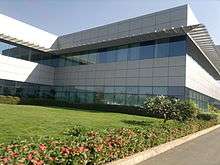
Pune has the fifth largest metropolitan economy and the sixth highest per capita income in the country.[130][131] The key sectors of the local economy are education, manufacturing and information technology (IT).
Pune has historically been known as a center for higher education and has been referred to as the educational capital of India. In 2016, it was reported that nearly 500,000 students from across India and abroad study in Pune at nine universities and more than a hundred educational institutes.[132][133]

The Kirloskar Group came to Pune in 1945 when Kirloskar Brothers Ltd setup Kirloskar Oil Engines, India's largest diesel engine company, at Khadki.[134][135] The group has several group companies in Pune including Kirloskar Pneumatics and the groups flagship company Kirloskar Brothers Limited, one of India's largest manufacturers and exporters of pumps and the largest infrastructure pumping project contractor in Asia.[136][137] Automotive companies such as Bajaj Auto, Tata Motors, Mahindra & Mahindra, Skoda cars, Mercedes Benz, Force Motors, Kinetic Motors, General Motors, Land Rover, Jaguar, Renault, Volkswagen, and Fiat have set up greenfield facilities near Pune, leading The Independent to describe Pune as India's "Motor City".[138] According to the Indo-German Chamber of Commerce, Pune has been the single largest hub for German companies for the last 60 years. Over 225 German companies have set up their businesses in Pune.[139][140] Serum Institute of India, the world's fifth largest vaccine producer by volume, has a manufacturing plant located in Pune.[141] In 2014-15, the manufacturing sector provided employment to over 500,000 people.[142]
The Rajiv Gandhi Infotech Park in Hinjawadi is a ₹ 60,000 crore (US$8.9 billion) project by the Maharashtra Industrial Development Corporation (MIDC).[143][144] The IT Park encompasses an area of about 2,800 acres (11 km2) and is home to over 800 IT companies of all sizes.[145][142] Besides Hinjawadi, IT companies are also located at Magarpatta, Kharadi and several other parts of the city. As of 2017, the IT sector employs more than 300,000 people.[145][142]
Pune has also emerged as a new hub for tech startups in India.[146][147][148] NASSCOM, in association with MIDC, has started a co-working space for city based startups under its 10,000 startups initiative at Kharadi MIDC.[149] Pune Food Cluster development project is an initiative funded by the World Bank. It is being implemented with the help of Small Industries Development Bank of India, Cluster Craft to facilitate the development of the fruit and vegetable processing industries in and around Pune.[150][151]
The Meetings, Incentives, Conferencing, Exhibitions trade is expected to be boosted since the Pune International Exhibition and Convention Centre (PIECC) opened in 2017. The 97-hectare PIECC boasts a seating capacity of 20,000 with a floor area of 13,000 m2 (139,931 sq ft). It has seven exhibition centres, a convention centre, a golf course, a five-star hotel, a business complex, shopping malls, and residences. The US$115 million project was developed by the Pimpri-Chinchwad New Town Development Authority.[152]
Culture
Architecture

Historical attractions include the 8th century rock-cut Pataleshwar cave temple, the 18th century Shaniwarwada, the 19th century Aga Khan Palace, Lal Mahal and Sinhagad fort. Shinde Chhatri, located at Wanowrie, is a memorial dedicated to the great Maratha general, Mahadaji Shinde (Scindia).[153]The old city had many residential buildings with courtyards called Wada. However, many of these have been demolished and replaced by modern buildings. A renowned wada in Pune is the last residential palace of the Peshwa called Vishrambaug Wada which is currently being renovated by the city corporation.[154]The city is also known for its British Raj bungalow architecture and the Garden Cities Movement layout of the Cantonment from the early 20th century. Landmark architectural works by Christopher Charles Benninger surround the city, including the Mahindra United World College of India, the Centre for Development Studies and Activities, the YMCA Retreat at Nilshi and the Samundra Institute of Maritime Studies.
Museums, parks and zoos
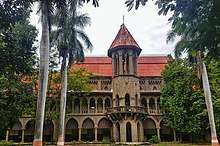
Museums in Pune include the Raja Dinkar Kelkar Museum, Mahatma Phule Industrial Museum, Deccan college museum of Maratha history[155], Dr. Babasaheb Ambedkar Museum, Joshi's Museum of Miniature Railway and the Pune Tribal Museum. Pune also houses Blades of Glory Cricket Museum which is the biggest cricket museum in the world. The College of Military Engineering has an archive and an equipment museum; this includes a rail exhibit with a metre-gauge train.The Aga Khan Palace, where Mahatma Gandhi was interned during the Quit India movement, has a memorial dedicated to his wife, Kasturba Gandhi who died here during the internment.
Parks and green spaces in the city include the Kamala Nehru Park, Sambhaji Park, Shahu Udyan, Peshwe Park, Saras Baug, Empress Gardens, and Bund Garden . The Pu La Deshpande Udyan is a replica of the Korakuen Garden in Okayama, Japan.[156] The Hanuman hill, Vetal hill, and Taljai Hills are protected nature reserves on hills within the city limits.
The Rajiv Gandhi Zoological Park is located in Katraj.[157] The zoo, earlier located at Peshwe Park, was merged with the reptile park at Katraj in 1999.
Performing arts
Both experimental and professional theatre receive extensive patronage from the Marathi community. The Tilak Smarak Ranga Mandir, Bal Gandharva Ranga Mandir, Bharat Natya Mandir, Yashwantrao Chavan Natya Gruha, and Sudarshan Rangmanch are prominent theatres in the city.[158][159][160]
Ganesh Kala Krida Rangamanch is the largest indoor theatre in the city, with a seating capacity of approximately 45,000.[161] The Sawai Gandharva Sangeet Mahotsav, one of the most prominent and sought-after Indian classical music festivals in India, is held in Pune every year in December. It commemorates the life and achievements of Sawai Gandharva.[162] The concept of Diwāḷī Pahāṭ (lit. Diwali dawn) originated in Pune as a music festival on the morning of the festival of Diwali.[163]
Sport
As a matter of historic interest, early on, the game of badminton was also known as Poona or Poonah after the then British garrison town of Poona where it was particularly popular and where the first rules for the game were drawn up in 1873. (Games employing shuttlecocks have been played for centuries across Eurasia, but the modern game of badminton developed in the mid-19th century among the British as a variant of the earlier game of battledore and shuttlecock. "Battledore" was an older term for "racquet".)[164][165]
Popular games and sports in Pune include athletics, cricket, basketball, badminton, field hockey, football, tennis, kabaddi, paragliding, kho-kho, rowing, and chess. The Chhatrapati Shivaji Stadium in Balewadi is the venue for wrestling and other traditional sports. The Royal Connaught Boat Club is one of several boating clubs on the Mula-Mutha river. Pune has basketball courts at the Deccan Gymkhana and at Fergusson College.[166] Pune Skatepark is a skateboarding park built in Sahakarnagar, consisting of an eight-foot bowl in a 3,000 square foot flatground.[167] Other prominent sporting institutions in Pune include the Nehru Stadium, the PYC Hindu Gymkhana, the Poona Golf Club and the Poona Cricket Club.
The Pune International Marathon is an annual marathon conducted in Pune. The National Games of 1994 and the 2008 Commonwealth Youth Games were held in the city at the Balewadi Stadium. The Deccan Gymkhana has hosted Davis Cup matches on several occasions. The 37,000 seating capacity Maharashtra Cricket Association Stadium has hosted international cricket – T20s, One Day Internationals, and a test match.[168] The National Education Foundation organises Enduro3, a cross country adventure race in Pune. It is a two- or three-day event with activities including cycling, trekking, river-crossing and rifle shooting.[169] Pune Race Course was built in 1830 on 118.5 acres (0.480 km2) of land and is managed by the Royal Western India Turf Club. The course has two training tracks and two racing surfaces. The racing season is from July to October every year and includes major racing events the Pune Derby, the RWITC Invitational, the Independence Cup and the Southern Command Cup.[170] The city has also hosted the 2009 FIVB Men's Junior World Championship.
Teams
The Maharashtra cricket team, one of the three teams of the Maharashtra Cricket Association that compete in interstate matches and leagues such as the Ranji Trophy, is based in the city. Pune Warriors India (2011-2014) and Rising Pune Supergiant (2016-2017) were the two teams based in Pune to play in the Indian Premier League.[171] Poona District Football Association (PDFA) was established in 1972 and currently has more than 100 registered teams.[172] FC Pune City was an Indian Super League football club in Pune. Established in 2014, FC Pune City became the only professional football club in India to have teams which participated at all levels of professional football; Senior Team (ISL), U-18 Team (I-League U-18), U- 16 Team, U-14 Team and the Women's Team.[173] The city is home to the Pune Peshwas, runners-up in the 2015 UBA Pro Basketball League season. Pune also has an American football franchise, called the Pune Marathas, which began playing in the inaugural season of the Elite Football League of India in 2011 and which plays at the Balewadi Stadium.[174][175]
Government and public services
Civic administration
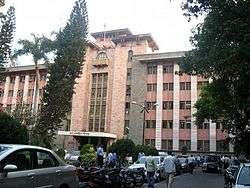
Pune Municipal Corporation (PMC) is the civic body responsible for local government. It comprises two branches, the executive branch headed by the Municipal Commissioner, an IAS officer appointed by the Government of Maharashtra, and an elected deliberative branch, the general body, headed by the Mayor of Pune.[176] Municipal elections are held every five years to elect councillors, commonly known as "corporators", who form the general body. The current general body of the PMC elected in February 2017 has 162 corporators representing 41 multi-member wards (39 with 4 corporators each and 2 with 3 each).[177] The general body, in turn, elects the mayor and the deputy mayor. The mayor has a ceremonial role as the first citizen and ambassador of the city while the actual executive power lies with the municipal commissioner. For policy deliberations, corporators form several committees. Perhaps the most important of these is the 16-member Standing Committee, half of whose members retire every year.[178] The Standing Committee and the 15 ward committees are in charge of financial approvals.[176] PMC was ranked 8th out of 21 Indian cities for best governance and administrative practices in 2014. It scored 3.5 out of 10 compared to the national average of 3.3.[179]
The Pune City Police Department is the law enforcement agency for the twin cities of Pune and Pimpri-Chinchwad. It is a division of the Maharashtra Police and is headed by the Police Commissioner, an officer of the Indian Police Service. The Pune Police Department reports to the State Ministry of Home Affairs. A separate police commissionerate was announced for Pimpri-Chinchwad in April 2018 to be carved out of Pune Police Department.[180][181] The new commissionerate took charge on 15 August 2018.[182][183]
Pune Metropolitan Region Development Authority (PMRDA) was formed on 31 March 2015 and is responsible for the integrated development of the PMR.[184] Currently its jurisdiction extends over 7,256.46 km2 (2,802 sq mi) and includes two municipal corporations, three cantonment boards, seven municipal councils, 13 census towns and 842 villages.[88][90]
Utility services
The PMC supplies the city with potable water that is sourced from the Khadakwasla Reservoir. There are five other reservoirs in the area that supply water to the city and the greater metropolitan area.[185]
The city lacks the capacity to treat all the sewage it generates, which leads to the Mutha river containing only sewage outside the monsoon months.[186] In 2009 only 65% of sewage generated was treated before being discharged into the rivers.[185] PMC is also responsible for collecting solid waste. Around 1,600 tons of solid waste is generated in Pune each day. The waste consists of 53% organic, compostable material; and 47% inorganic material, of which around half is recyclable. The unrecovered solid waste is transported to the dumping grounds in Urali devachi.[187]
The state owned Maharashtra State Electricity Distribution Company Limited supplies electricity to the city. Bharat Sanchar Nigam Limited (BSNL), owned by the central government, as well as private enterprises such as Vodafone, Bharti Airtel, Reliance, Idea Cellular, Tata DoCoMo, Tata Teleservices, and Virgin Mobile, are the leading telephone and cell phone service providers in the city.[188]:25–26:179
Education and research
Pune has over a hundred educational institutes and more than nine deemed universities apart from the Savitribai Phule Pune University (SPPU; formerly University of Pune), which is the largest University in the country based on total number of affiliated colleges.[189] Higher education institutes attract international students mainly from the Middle Eastern countries such as Iran, and United Arab Emirates, and also African countries such as Ethiopia and Kenya.[190] Pune is the largest centre for Japanese learning in India.[191] Other languages taught in the city include German, which is taught at the Goethe-Institut, and French, which is taught at Alliance Française.Several colleges in Pune have student exchange programmes with colleges in Europe.[192]
Primary and secondary education
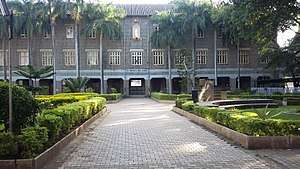
The PMC runs 297 primary schools and 30 secondary and higher secondary schools.[193][194] While it is mandatory for the PMC to provide primary education under state law, secondary education is an optional duty.[194][195][196] In the rural and suburban areas of the PMR, public primary schools are run by the Pune Zilla Parishad. Private schools are run by education trusts and are required to undergo mandatory inspection by the concerned authorities. Private schools are eligible for financial aid from the state government.[197] Public schools are affiliated to the Maharashtra State Board of Secondary and Higher Secondary Education (State Board). The language of instruction in public schools is primarily Marathi, although the PMC also runs Urdu, English and Kannada medium schools.[194][198][199] Along with these languages, private schools also offer instruction in Hindi and Gujarati.[200] Private schools vary in their choice of curriculum and may follow the State Board or one of the two central boards of education, the CBSE or CISCE.[201][202]
Tertiary education
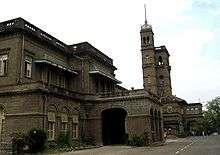
Most colleges in Pune are affiliated to the SPPU (Savitribai Phule Pune University). Nine other universities have also been established in the city.[203] Pune also hosts the Military Intelligence Training School which offers diploma courses in counter intelligence, combat intelligence, aerial imagery and interpretation, among others.[204]
The College of Engineering Pune, an autonomous institute of the government of Maharashtra founded in 1854, is the third oldest engineering college in Asia. The Deccan Education Society was founded by local citizens in 1884, including social and political activist Bal Gangadhar Tilak, who was also responsible for founding Fergusson College in 1885.[205] The Indian Law Society's (ILS) Law College is one of the top ten law schools in India.[206] The Armed Forces Medical College (AFMC) and B. J. Medical College are among the top medical colleges in India. The AFMC consistently ranks among the top five medical colleges in India.[207] The Film and Television Institute of India, one of only three Indian institutions in the global CILECT film school network, is located on Law College Road. The Lalit Kala Kendra is an undergraduate department of Music, Dance and Drama on the SPPU campus that has been operational since 1987. This department features a combination of gurukul and formal education systems.[208]
Symbiosis International University operates 33 colleges and institutions in the city, including the Symbiosis Institute of Business Management, the Symbiosis Institute of Management Studies, the Symbiosis Centre for Management and Human Resource Development, the Symbiosis Law School and the Symbiosis Institute of International Business. They are ranked among the top management and law institutes in the country.[209][210] The Symbiosis Institute of Computer Studies and Research is one of the few colleges in India that promotes open source technology.[211]
Research Institutes
Pune is home to a number of governmental and non-governmental research institutes focusing on a wide range of subject areas from the humanities to the sciences. The Ministry of Defence also runs a number of defence related education, training and research establishments in and around the city. Major research centers include:
- Agharkar Research Institute (ARI)
- Armament Research Development Establishment (ARDE)
- Army Institute of Technology (AIT)
- Automotive Research Association of India (ARAI)
- Bhandarkar Oriental Research Institute (BORI)
- Central Institute of Road Transport (CIRT)[212]
- Central Water and Power Research Station (CW&PRS)
- Centre for Development of Advanced Computing (C-DAC)[213]
- Defence Research and Development Organisation (DRDO)
- Defence Institute of Advanced Technology (DIAT)[214]
- National Defence Academy (NDA)
- Gokhale Institute of Politics and Economics
- High Energy Materials Research Laboratory (HEMRL)
- Indian Institute of Science Education and Research, Pune (IISER, Pune)
- Film and Television Institute of India
- Indian Institute of Tropical Meteorology (IITM) – scientists at IITM has made significant achievements in tropical weather[215]
- Inter-university Centre for Astronomy & Astrophysics (IUCAA)
- National Centre for Cell Science (NCCS)
- National Centre for Radio Astrophysics (NCRA)
- National Chemical Laboratory (NCL) – one of the leading chemical research establishments in India
- National Informatics Centre (NIC)
- National Institute of Bank Management (NIBM)
- National Institute of Construction Management and Research (NICMAR) – India's most reputed institute for Construction Management
- National Institute of Virology (NIV)
- National School of Leadership (NSL)
- National Insurance Academy (NIA)
- Research & Development Establishment (Engineers) (R&DE(E))
- Tata Research Development and Design Centre (TRDDC)
Media
A number of Marathi-language newspapers from the British era continued publishing decades after independence. These included Kesari, Tarun Bharat, Prabhat andSakal.[216] Sakal has remained the most popular Marathi daily.[217][218] Kesari is now only published as an online newspaper. Mumbai based Maharashtra Times, Loksatta and Lokmat have all introduced Pune based editions in the last fifteen years. The Mumbai-based popular English newspaper the Indian Express has a Pune edition. Its rival the Times of India introduced a tabloid called Pune Mirror in 2008. Mid Day, Daily News and Analysis and Sakaal Times are other local English newspapers. The English-language newspaper The Hindu has launched a Pune edition covering local as well as national news.
The government owned All India Radio (AIR) has been broadcasting from Pune since 1953.[219] Savitribai Phule Pune University broadcasts programmes focusing on its different departments and student welfare schemes on its own FM radio channel called Vidyavani.[220] A number of commercial FM channels are also received in the city.[221] The city receives almost all of the television channels in India including broadcast, cable and direct-to-home TV.
Transport
Public transport

Public transport in Pune includes Pune Suburban Railway, bus services operated by PMPML and auto rickshaws. Uber and Ola Cabs also operate in the city. Construction of Pune Metro, an urban mass rapid transit system, is underway as of 2018.[222]
Rail
Pune Suburban Railway (electric multiple units) (popularly called local trains) connect Pune to the industrial city of Pimpri-Chinchwad and the hill station of Lonavala. Daily express trains connect Pune to Mumbai, Nashik, Ahmedabad, Chennai, Delhi, Hyderabad, Jaipur, Raipur, Nagpur, Visakhapatnam, Thiruvananthapuram, Kochi, Coimbatore, Bangalore, Allahabad, Kanpur, Howrah, Jammu Tawi, Vijayawada, Darbhanga, Goa, Gwalior, Varanasi, Bhubaneswar, Ranchi, Patna, and Jamshedpur. At Pune, there is a diesel locomotive shed and an electric trip shed.[223] Pune Railway Station is administered by the Pune Railway Division of Central Railways.[224]
Bus service
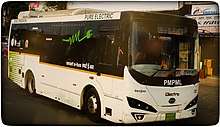
Public buses within the city and its suburbs are operated by Pune Mahanagar Parivahan Mahamandal Limited (PMPML). PMPML operates the Rainbow BRTS system, the first of its kind in India, in which dedicated bus lanes were supposed to allow buses to travel quickly through the city. The project has turned out to be a failure, receiving little patronage from the local citizenry.[225] Maharashtra State Road Transport Corporation runs buses from stations in Wakdewadi, Pune station, and Swargate to all major cities and towns in Maharashtra and neighbouring states. Private companies also run buses to major cities throughout India.[226] In January 2019, Pune became the first Indian city to adopt e-buses and Bhekrai Nagar the country's first all electric bus depot. As of November 2019, up to 133 electric vehicles (EVs) have been deployed across the city in the first phase of its e-bus programme.
Metro
Pune Metro, a mass rapid transit system, is under construction and is expected to be operational by 2021.[227][228] The detailed project report was prepared for the initial two lines by Delhi Metro Rail Corporation which was approved by the State government in 2012 and by the central government in December 2016.[229][230][231] Two lines, Line 1 from Pimpri Chinchwad Municipal Corportion Building to Swargate and Line 2 from Ramwadi to Vanaz, with a combined length of 31.25 kilometres (19.42 mi), are being constructed by MahaMetro, a 50:50 joint venture of the State and central governments.[232] Line 1 will run underground between Swargate and Range Hills be and elevated until Pimpri Chinchwad. Line 2 will be completely elevated and will intersect Line 1 at the Civil Court interchange station in Shivajinagar.[233]
Line 3 between Hinjawadi and Civil Court, Shivajinagar was approved by the state and central governments in January and March 2018, respectively.[234][235] This 23.3-km line is being implemented by PMRDA on a public-private partnership basis.[236]
Road transport
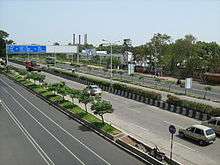
Pune is well-connected to other cities by Indian and state highways. National Highway 48 connects it to Mumbai and Bangalore, National Highway 65 connects it to Hyderabad and National Highway 60 connects it to Nashik. State Highway 27 connect Pune to Ahmednagar.
The Mumbai Pune Expressway is India's first six-lane high-speed expressway, and it was built in 2002. Only four wheeled vehicles are allowed on it. This expressway has reduced travel time between Pune and Mumbai to a little over two hours. A ring road is planned around the city.[237][238][239]
Personal transport
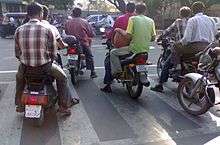
Once known as the "cycle city of India", Pune has experienced a rapid growth in the number of motorised two wheelers replacing the bicycle.[240] In 2005 the city was reported to have one million two wheelers. The report also stated that the increase in vehicular and industrial activity had led to a 10-fold increase in particulate pollution in some areas of the city.[241] In 2018 the number of vehicles in the city has exceeded its population with 3.62 million total vehicles, 2.70 million being two wheelers.[242][243] In the fiscal year 2017–18 alone 300,000 new vehicles were registered in the city, two-thirds of them two wheelers.[244]
A revival of cycling in Pune with 130 kilometres (81 mi) of cycle tracks built was attempted as a part of the BRT system under the Jawaharlal Nehru National Urban Renewal Mission in 2004. However, a 2011 report revealed that only 88 kilometres (55 mi) of tracks were actually built and most were unusable at the time of the report.[245][246] Under the Smart Cities Mission, app based cycle sharing schemes have been launched in the city since late 2017.[247][248][249] The PMC has devised the Pune Cycle Plan with 470 kilometres (290 mi) of cycle tracks planned.[250][251][252] Cycles are also seen as a possible way of improving last mile connectivity for the metro system.[253]
Air
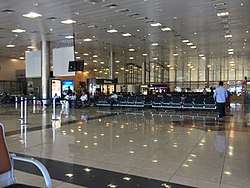
Pune International Airport at Lohegaon is one of the busiest airports in India. The airport is operated by the Airports Authority of India. It shares its runways with the neighbouring Indian Air Force base.[254] In addition to domestic flights to all major Indian cities, the airport has international direct flights to Dubai, operated by Air India Express,[255] and SpiceJet.
A new international airport has been proposed, due to the limited capacity of the existing airport. A location in the Chakan-Rajgurunagar area was chosen for the airport,[256][257] but non-availability of land delayed the project for over a decade.[258] In September 2016 the location was changed to Purandar, c. 20 kilometres (12 mi) south of the city.[259][260] The proposed airport in Purandar will be spread over 2,400 hectares. Chhatrapati Sambhaji Raje Airport is proposed to serve the city of Pune. The greenfield airport will be located near the villages of Ambodi, Sonori, Kumbharvalan, Ekhatpur-Munjawadi, Khanwadi, Pargaon Memane, Rajewadi, Aamble, Tekwadi, Vanpuri, Udachiwadi, Singapur near Saswad and Jejuri in Purandar taluka of Pune District.
Healthcare

Healthcare in the PMR is provided by private and public facilities. Primary care is provided by practitioners of western as well as traditional alternative medicine (i.e.Ayurved, Homeopathy and Unani). For minor and chronic ailments, people in the region have preference for practitioners of the traditional medicine.[261]
The PMR is served by three government hospitals: Sassoon Hospital, Budhrani and Dr Ambedkar Hospital. There are also a number of private hospitals such as Ranka Hospital, Sahyadri, Jahangir Nursing Home, Sancheti Hospital, Aditya Birla Memorial Hospital, KEM Hospital, Ruby Hall, Naidu Hospital[262] and Dinanath Mangeshkar Hospital.
International relations
World Trade Center (WTC) Pune is a 1.6 million sq. ft. infrastructure to foster international trade. WTC Pune is part of the World Trade Centers Association.[263][264]
- Twin towns and sister cities



Informal relationship
See also
- List of people from Pune
- List of tourist attractions in Pune
- Pune Mahanagar Parivahan Mahamandal Limited
- Pune Metro
- Chhatrapati Sambhaji Raje International Airport
References
- Choudhuri, Debjani Pal (2007). Community Planning for Intervention for Victims of Domestic Violence. Kassel University Press. p. 35. ISBN 978-3-89958-346-5.
- Diddee, Jaymala (2000). Pune: Queen of the Deccan. Elephant Design Pvt. Limited. ISBN 978-8187693000.
- "Pune History - Origin and History of Poona India". Archived from the original on 25 February 2019. Retrieved 25 February 2019.
- "Municipal Commissioner Office, Pune". Official website of the Pune Municipal Corporation.
- https://indianexpress.com/article/cities/pune/pune-vikram-kumar-takes-over-as-pmc-chief-6502623/
- PTI (23 November 2019). "BJP's Murlidhar Mohol Elected New Mayor of Pune". NDTV.com. Retrieved 13 March 2020.
- "11 newly merged villages in PMC rife with illegal constructions – Pune Mirror -". Pune Mirror. Archived from the original on 18 April 2018. Retrieved 25 April 2018.
- "State approves merger of 11 villages, Pune adds 81sqkm [sic]– Times of India". The Times of India. Archived from the original on 25 June 2018. Retrieved 25 April 2018.
- "Pune Metropolitan Region Development Authority – PMRDA". www.pmrda.gov.in. Archived from the original on 26 April 2018. Retrieved 25 April 2018.
- "PMRDA eyes big boost to affordable housing sector – Times of India". The Times of India. Archived from the original on 25 June 2018. Retrieved 25 April 2018.
- "District Census Handbook – Pune" (PDF). Census of India. The Registrar General & Census Commissioner. p. 28. Archived (PDF) from the original on 11 March 2016. Retrieved 1 June 2016.
- Paik, Shailaja (11 July 2014). Dalit Women's Education in Modern India: Double Discrimination. Routledge. p. 195. ISBN 9780415493000. Retrieved 25 May 2019.
- Bharucha, Hoshang (25 September 2018). Glimpses of Guruprasad. Notion Press. ISBN 9781644290231. Retrieved 25 May 2019.
- "PIN Code: Pune, Maharashtra, India". findpincode.net. Archived from the original on 8 April 2016. Retrieved 18 March 2016.
- "Members : Lok Sabha". 164.100.47.194. Archived from the original on 30 April 2018. Retrieved 29 April 2018.
- "BJP anil shirole won Pune lok sabha seat by 3.15 lakh votes defeating vishwajeet kadam of congress. – Times of India". The Times of India. Archived from the original on 30 April 2018. Retrieved 29 April 2018.
- "Definition of Pune". The Free Dictionary. Archived from the original on 13 December 2013. Retrieved 9 December 2013.
- "Define Pune". Dictionary.com. Archived from the original on 12 December 2013. Retrieved 9 December 2013.
- "Culture, colleges, cyber hubs: Fifteen things to know about Pune". Hindustan Times. 24 June 2017. Archived from the original on 30 April 2018. Retrieved 29 April 2018.
- Atre, Abhijit (30 September 2016). "What's in a name? A lot when it comes to Pune – Times of India". The Times of India. Archived from the original on 16 June 2018. Retrieved 29 April 2018.
- Chakravorty, Abhimanyu (13 April 2016). "From Gurgaon to Gurugram: 20 cities that changed their names". The Indian Express. Archived from the original on 30 April 2018. Retrieved 29 April 2018.
- "Pune is also ranked No. 1 city in country in 'ease of living' ranking". TOI. 14 August 2018. Archived from the original on 13 October 2018. Retrieved 13 October 2018.
- "Constituents of Urban Agglomerations having Population 1 lakh and above – Census of India 2011" (PDF). Office of the Registrar General & Census Commissioner, India. p. 34 of 61. Archived (PDF) from the original on 25 October 2017.
- Nalawade, S.B. "Geography of Pune Urban Area". Ranwa. Archived from the original on 22 December 2007. Retrieved 4 April 2008.
- "Shaniwarwada was centre of Indian politics: Ninad Bedekar". Daily News and Analysis. 29 November 2011. Archived from the original on 26 January 2012. Retrieved 19 April 2012.
- Kanhere, G.K., 1993. Planning for the Pune Region. Architecture Plus Design, 10(6), p.60.
- Joshi, S.R., 1996. Mass media and cultural identity: Issues of ethnic co‐existence in India. Asian Journal of Communication, 6(1), pp.124–139.
-
- Ramnath Subbu (13 September 2010). "Pune shifts to top most gear as automobile hub". The Hindu. Retrieved 4 March 2017.
- Partha Sarathi Biswas. "Global city GDP rankings 2008–2025". Indian Express Limited. Retrieved 10 July 2017.
- Krishnamurthy, Rashmi; Mishra, Rajeev; Desouza, Kevin C. (April 2016). "City profile: Pune, India". ScienceDirect. Elsevier. 53: 98–109. doi:10.1016/j.cities.2016.01.011. Retrieved 5 July 2020.
- Gulhane, Vidyadhar; Tarambale, M. R.; Nerkar, YP (23 April 2007). "A Scope for the Research and Development Activities on Electric Vehicle Technology in Pune City". 2006 IEEE Conference on Electric and Hybrid Vehicles. IEEE. pp. 1–8. doi:10.1109/ICEHV.2006.352285. ISBN 978-0-7803-9793-4. S2CID 26480235.
- "The 'Oxford of the East' goes West". The Indian Express. Archived from the original on 24 April 2017. Retrieved 24 January 2017.
- "Truly the Oxford of the East". Hindustan Times. Archived from the original on 2 February 2017. Retrieved 24 January 2017.
- Wadekar, Disha (19 January 2020). "History Headline: The true daughters of Savitribai Phule". The Indian Express. Retrieved 22 July 2020.
- "Serial Blasts Rock Oxford of the East". Little India. Retrieved 24 January 2017.
- Byatnal, Amruta (15 July 2012). "Why Pune is an international favourite". The Hindu. ISSN 0971-751X. Archived from the original on 12 October 2013. Retrieved 29 April 2018.
- "India Maharashtra Pune History Event Of Pune Time Line Of Pune (Punediary.com)". www.punediary.com. Archived from the original on 29 April 2018. Retrieved 28 April 2018.
- "Pune History – Origin & History of Pune – History of Puna India – History of Pune City". Pune.org.uk. Archived from the original on 28 June 2010. Retrieved 16 July 2010.
- "What's in a name? A lot when it comes to Pune".
- JOGLEKAR, P.P.; DEO, SUSHAMA G.; BALAKAWADE, PANDURANG; DESHPANDE-MUKHERJEE, ARATI; RAJAGURU, S.N.; KULKARNI, AMOL N. (2006). "A New Look at Ancient Pune Through Salvage Archaeology (2004-2006)". Bulletin of the Deccan College Research Institute. 66/67: 211–225. JSTOR 42931448.
- Govind Sakharam Sardesai (1957). New History of the Marathas: Shivaji and his line (1600–1707). Phoenix Publications. p. 58. Archived from the original on 3 November 2013. Retrieved 26 October 2016.
- Gunaji, Milind (2003). Offbeat tracks in Maharashtra. Mumbai: Popular Prakashan. pp. 68–69. ISBN 978-8171546695. OCLC 54822004.
- Government, of Bombay (1885). Gazetteer of the Bombay Presidency: Pune (2 pts.). p. 321.
- "Monuments in Pune". Pune district administration. Archived from the original on 25 March 2008. Retrieved 4 April 2008.
- "The history of Muhiyabad err...Pune". Archived from the original on 31 October 2014. Retrieved 31 October 2014.
- S. N. Sen (2006). History Modern India. New Age International. p. 12. ISBN 978-81-224-1774-6.
- "Shrimant Bajirao Peshwa : Great warrior and protector of Hindu Dharma | Hindu Janajagruti Samiti". Hindujagruti.org. Archived from the original on 29 June 2014. Retrieved 7 August 2014.
- "पुणे जिल्हा ऐतिहासिक महत्त्वाचे". Manase.org. Archived from the original on 15 May 2014. Retrieved 14 May 2014.
- Kosambi, Meera (1989). Gokhale, Balkrishna Govind (ed.). "Glory of Peshwa Pune". Economic and Political Weekly. 24 (5): 247–250. JSTOR 4394341.
- Gokhale, Balkrishna Govind (1985). "The Religious Complex in Eighteenth-Century Pune". Journal of the American Oriental Society. 105 (4): 719–724. doi:10.2307/602730. JSTOR 602730.
- Khare, K. C.; Jadhav, M. S. (2008). "Water Quality Assessment of Katraj Lake, Pune (Maharashtra, India): A Case Study" (PDF). Proceedings of Taal2007. The 12th World Lake Conference: 292–299. Archived from the original (PDF) on 17 April 2018. Retrieved 28 April 2018 – via Ministry of Environment and Forests, Govt. of India.
- Brahme, Sulabha; Gole, Prakash (1967). Deluge in Poona: Aftermath and rehabilitation. Poona: Gokhale Institute of Politics and Economics; Asia Publishing House. pp. 14–47.
- "It's true: Peshwa-era water duct still fresh! – Times of India". The Times of India. Archived from the original on 20 June 2018. Retrieved 20 April 2018.
- Preston, Laurence W. (April 2002). "Shrines and neighbourhood in early nineteenth-century Pune, India". Journal of Historical Geography. 28 (2): 203–215. doi:10.1006/jhge.2001.0398. ISSN 0305-7488.
- "Shaniwarwada was centre of Indian politics: Ninad Bedekar – Mumbai – DNA". Dnaindia.com. 29 November 2011. Archived from the original on 20 March 2013. Retrieved 17 October 2013.
- M. S. Naravane (2006). Battles of the Honourable East India Company: Making of the Raj. APH Publishing. pp. 80–86. ISBN 978-81-313-0034-3.
- Balkrishna Govind Gokhale (1988). Poona in the Eighteenth Century: An Urban History. Oxford University Press. pp. 111, 112.
The caste composition of these leaders throws interesting light on the nature and functioning of the upper echelons of Poona society. The late Professor G.S.Sardesai compiled a list of prominent historical families who played significant political, military and financial roles in Poona's affairs during the Eighteenth Century. The list contains the names and geneologies of 163 families. The caste affiliations of the families are Deshasthas 80 Chitpawans 46 Chandraseniya Kayastha Prabhus 15 Karhadas 11 Saraswats 11.
- Pike, John. "India – Army Southern Command Order of Battle". www.globalsecurity.org. Archived from the original on 29 April 2018. Retrieved 28 April 2018.
- "Southern Command HQ set to archive Army's glory | Latest News & Updates at Daily News & Analysis". dna. 12 November 2013. Archived from the original on 5 July 2018. Retrieved 31 May 2018.
- "Southern Command: Army's shining star". OneIndia. Archived from the original on 4 July 2018. Retrieved 31 May 2018.
- Gazetteer of The Bombay Presidency: Poona (Part 2). Government Central press. 1885. p. 156.
- Gazetteer of the Bombay Presidency: Poona (2 pts.). Government Central Press. 1885. p. 308.
- "The Other Liberal Light". The New Republic. Archived from the original on 20 June 2018. Retrieved 28 April 2018.
- John B. Severance (1997). Gandhi, Great Soul. Houghton Mifflin Harcourt. pp. 113–115. ISBN 978-0-395-77179-2.
- "PMC". Archived from the original on 27 September 2007. Retrieved 5 January 2020.
- "History of University". Official website of the SPPU. Archived from the original on 8 June 2018. Retrieved 31 May 2018.
- "National Chemical Laboratory". www.ncl-india.org. Archived from the original on 1 June 2018. Retrieved 31 May 2018.
- "History of NDA". Official website of the National Defence Academy, Pune. Archived from the original on 14 July 2017. Retrieved 31 May 2018.
- B.D. Kolekar (1993). Human Resources Development. Northern Book Centre. pp. 17–19. ISBN 978-81-7211-044-4.
- "Historical Events in Pune". NIC – District-Pune. Archived from the original on 2 December 2008. Retrieved 29 October 2009.
- Menon, Sudha (30 March 2002). "Pimpri-Chinchwad industrial belt: Placing Pune at the front". The Hindu Business Line. Archived from the original on 14 April 2012. Retrieved 29 January 2012.
- Heitzman, James (2008). The city in South Asia. London: Routledge. p. 213. ISBN 978-0415574266. Retrieved 14 November 2016.
pune.
- "Tata Motors Manufacturing Facility - Pune". www.tatamotors.com. Archived from the original on 12 June 2018. Retrieved 31 May 2018.
- Brahme, S; GOLE, P. (1967). Deluge in Poona. GOKHALE INSTITUTE OF POLITICS AND ECONOMIC Asia Publishing House. pp. 14–47.
- Singh, Vijay P. (1996). Dam breach modeling technology. Dordrecht: Kluwer Academic Publishers. pp. 89–91. ISBN 978-0792339250. Retrieved 14 November 2016.
- Joshi, Ashutosh (2008). Town planning regeneration of cities. New Delhi: New India Pub. Agency. p. 74. ISBN 9788189422820. Retrieved 4 February 2017.
- "The Mumbai-Pune expressway". The Financial Express. Archived from the original on 15 May 2013. Retrieved 29 October 2009.
- "Pune to get piped compressed natural gas before CYG". The Punekar. Archived from the original on 4 October 2008. Retrieved 29 October 2009.
- Harmeet Singh (13 February 2010). "Eight killed in India restaurant blast". CNN. Archived from the original on 16 February 2010. Retrieved 14 February 2010.
- "9 killed, 40 injured in Pune bomb blast". The Hindu. PTI. 13 February 2010. ISSN 0971-751X. Retrieved 28 April 2018.
- The WorldNews (WN) Network (14 February 2010). "पुण्यावर दहशतवादी हल्ला; नऊ ठार, ५७ जखमी" (in Marathi). article.wn.com/. Retrieved 13 February 2010.
- Harsh V. Pant (6 October 2015). Handbook of Indian Defence Policy: Themes, Structures and Doctrines. Taylor & Francis. ISBN 978-1-317-38008-5.
- "Geographical location". About Pune—District Pune, Government of Maharashtra. Government of Maharashtra. Archived from the original on 29 January 2019. Retrieved 28 January 2019.
- Heitzman, James (2008). The City in South Asia. Routledge. p. 1. ISBN 978-1-134-28963-9.
- Joshi, Ashutosh (2008). Town planning regeneration of cities. New Delhi: New India Pub. Agency. pp. 73–84. ISBN 9788189422820.
- Bari, Prachi (7 December 2007). "Hinjewadi: The land of opportunity". The Economic Times. Archived from the original on 28 April 2018. Retrieved 27 April 2018.
- Kulkarni, Prachee (30 March 2012). "Rajiv Gandhi Infotech Park in Hinjewadi facing infrastructural problems". The Economic Times. Archived from the original on 28 April 2018. Retrieved 27 April 2018.
- "Wagholi grows, but traffic crawls on narrow stretch – Times of India". The Times of India. Archived from the original on 25 June 2018. Retrieved 28 April 2018.
- "Expanding Pune: Wagholi suffocating on fumes of garbage". Hindustan Times. 24 February 2018. Archived from the original on 29 April 2018. Retrieved 28 April 2018.
- "Pune Metropolitan Region Development Authority – PMRDA". www.pmrda.gov.in. Archived from the original on 26 April 2018. Retrieved 27 April 2018.
- "PMRDA gets state govt nod; notification soon, says CM". The Indian Express. 27 March 2015. Archived from the original on 25 July 2018. Retrieved 27 April 2018.
- "PMRDA area notified, DP to be announced in a year". The Indian Express. 20 June 2017. Archived from the original on 27 April 2018. Retrieved 27 April 2018.
- Bapat, Meera (2009). Poverty Lines and Lives of the Poor: Underestimation of Urban Poverty – the Case of India. London: International Institute for Environment and Development. p. 3. ISBN 978-1-84369-724-4.
- Butsch, Carsten; Kumar, Shamita; Wagner, Paul D.; Kroll, Mareike; Kantakumar, Lakshmi N.; Bharucha, Erach (2017). "Growing 'Smart'? Urbanization Processes in the Pune Urban Agglomeration". Sustainability. 9 (12): 2335. doi:10.3390/su9122335.
- SINGH, T. LALITH (2012). "What are integrated townships?". The Hindu (27 October). Archived from the original on 28 June 2014. Retrieved 28 February 2017.
- "Mercer Quality of Living Rankings". Mercer. Archived from the original on 20 November 2018. Retrieved 28 April 2017.
- "Quality of Living City Rankings". Mercer Information Solutions business. Archived from the original on 4 March 2015. Retrieved 3 March 2015.
- SHARMA, NIDHI (15 March 2018). "Pune adjudged best governed city". The Economic Times. Archived from the original on 26 March 2018. Retrieved 26 March 2018.
- Gadgil, D. R. (1945). Poona A Socio-Economic Survey Part I. Pune, India: Gokhale Institute of Politics and Economics. p. 14. Archived from the original on 29 December 2016. Retrieved 20 September 2016.
- "National Symposium on Nematode Management: A challenge to Indian Agriculture in the changing climate" (PDF). Nematological Society of India and Indian Council of Agricultural Research. 8–10 January 2015. p. 24. Archived from the original (PDF) on 27 April 2018. Retrieved 16 September 2018.
- "City sweats as mercury hits season's high". The Times of India. 17 April 2003. Archived from the original on 9 May 2013. Retrieved 10 May 2008.
- "Station: Pune Climatological Table 1981–2010" (PDF). Climatological Normals 1981–2010. India Meteorological Department. January 2015. pp. 627–628. Archived from the original (PDF) on 5 February 2020. Retrieved 5 April 2020.
- "Extremes of Temperature & Rainfall for Indian Stations (Up to 2012)" (PDF). India Meteorological Department. December 2016. p. M151. Archived from the original (PDF) on 5 February 2020. Retrieved 5 April 2020.
- "Table 3 Monthly mean duration of Sun Shine (hours) at different locations in India" (PDF). Daily Normals of Global & Diffuse Radiation (1971–2000). India Meteorological Department. December 2016. p. M-3. Archived (PDF) from the original on 5 February 2020. Retrieved 5 April 2020.
- "Pune prone to transmitive quake waves, says expert – Times of India". The Times of India. Archived from the original on 3 August 2018. Retrieved 19 April 2018.
- Dev, S. M. S. P.; Nagarajan, R. (2017). "Seismic hazard assessment of Koyna region, Peninsular India: using geospatial approach". Geoenvironmental Disasters. 4 (1). doi:10.1186/s40677-017-0092-y.
- "Seismic Zones". pib.nic.in. Archived from the original on 20 April 2018. Retrieved 19 April 2018.
- "High-risk seismic zones in India: How prone is your city to earthquakes". The Indian Express. 21 September 2017. Archived from the original on 12 April 2018. Retrieved 19 April 2018.
- "Demographics of Pune". Punepages.com. Archived from the original on 15 July 2011. Retrieved 16 July 2010.
- "Annexure I" (PDF). Fire Hazards Response and Mitigation Plan. Pune Municipal Corporation. 2001. p. 10. Archived from the original (PDF) on 15 May 2012. Retrieved 29 June 2012.
- "Pune's GDP at Rs 46,000 is 50 pc higher than India's". The Indian Express. 28 July 2006. Archived from the original on 10 January 2008. Retrieved 24 March 2007.
- "Revised Action Plan for Control of Air Pollution in Pune" (PDF). Census of India, Government of India (2001). Maharashtra Pollution Control Board. Archived from the original (PDF) on 26 February 2009. Retrieved 29 December 2008.
- Khairkar, V.P., 2008. Segregation of Migrants Groups in Pune City, India. Anthropologist, 10(2), pp.155–161.
- Barnouw, Victor (1966). "The Sindhis, Mercantile Refugees in India: Problems of Their Assimilation". Phylon (1960-). 27 (1): 40–49. doi:10.2307/273320. JSTOR 273320.
- Pordié, Laurent; Lalitha, N. (24 May 2006). "Research Update: Transversal Themes of Indian Society and Medicines" (PDF). Department of Social Sciences, The French Institute of Pondicherry. Archived from the original (PDF) on 20 July 2008.
- "Indian Urban Resource Millennium Assessment by Naturalists" (PDF). Archived (PDF) from the original on 11 September 2008. Retrieved 18 July 2008. (183 KB)
- "Pune to become 7th metro city in India: Assocham – Economy and Politics". livemint.com. 30 October 2008. Archived from the original on 30 April 2011. Retrieved 26 March 2011.
- "Socio – Economic Survey Of Pune City" (PDF). p. 273. Archived (PDF) from the original on 2 August 2016. Retrieved 6 November 2014.CS1 maint: location (link)
- Preston, Laurence W. "Shrines and neighbourhood in early nineteenth-century Pune, India. " Journal of Historical Geography 28. 2 (2002): 203-215.
- Kumar, Ravinder (2004). Western India in the Nineteenth century (Repr. ed.). London [u.a.]: Routledge. p. 39. ISBN 978-0415330480.
- Kosambi, Meera (1989). "Glory of Peshwa Pune". Economic and Political Weekly. 248 (5): 247.
- Gokhale, Balkrishna Govind (1985). "The Religious Complex in Eighteenth-Century Poona". Journal of the American Oriental Society. 105 (4): 719–724. doi:10.2307/602730. JSTOR 602730.
- "Shaniwarwada was centre of Indian politics: Ninad Bedekar – Mumbai – DNA". Dnaindia.com. 29 November 2011. Archived from the original on 20 March 2013. Retrieved 17 October 2013.
- Kantak, M. R. (1991–92). "Urbanization of Pune: How Its Ground Was Prepared". Bulletin of the Deccan College Research Institute. 51/52: 489–495. JSTOR 42930432.
- Bombay (India : State) (1885). Gazetteer of the Bombay Presidency ... Government Central Press. Archived from the original on 17 March 2015. Retrieved 29 June 2018.
- "Photo of Babajan's Samadhi tomb shrine in Pune". Trustmeher.com. Archived from the original on 17 July 2011. Retrieved 26 March 2011.
- "At Babajan Dargah rests the legacy of an old saint – Times of India". The Times of India. Archived from the original on 5 June 2018. Retrieved 25 May 2018.
- M. Whitney Kelting (2 August 2001). Singing to the Jinas: Jain Laywomen, Mandal Singing, and the Negotiations of Jain Devotion. Oxford University Press. pp. 8, 15. ISBN 978-0-19-803211-3. Archived from the original on 25 December 2016. Retrieved 2 July 2018.
- "The wanderers who found home - Pune Mirror -". Pune Mirror. Archived from the original on 25 June 2018. Retrieved 1 July 2018.
- "The Bene-Israel and Baghdadi Jews of India: A history of this minority community - Firstpost". www.firstpost.com. Archived from the original on 1 July 2018. Retrieved 1 July 2018.
- "Monsoon Festival at Osho Ashram begins today". The Indian Express. Pune. Archived from the original on 12 August 2018. Retrieved 12 August 2018.
- "Top Ten Wealthiest Towns of India". Maps of India. Archived from the original on 9 March 2012. Retrieved 1 March 2012.
- Haritas, Bhragu. "Richest Cities Of India". BW Businessworld. Archived from the original on 29 June 2018. Retrieved 26 June 2018.
- Kaul, S., 2006. Higher education in India; seizing the opportunity.INDIAN COUNCIL FOR RESEARCH ON INTERNATIONAL ECONOMIC RELATIONS Archived 27 June 2007 at the Wayback Machine
- Top universities of Largest metropolitan economy -Pune, January −31, 2015, AICTE David, 21 August 2013, archived from the original on 3 April 2015, retrieved 31 January 2015
- "K. K. Swamy appointed MD of Volkswagen India". The Indian Express. Retrieved 14 December 2009.
- "Kirloskar Oil Engines". India Business Insight. 31 August 2004. Archived from the original on 9 September 2011. Retrieved 14 December 2009.
- "Kirloskar Brothers restructure group". CNBC-TV18. Archived from the original on 6 December 2009. Retrieved 14 December 2009.
- "Pump Industry in India – Overview, Market, Manufacturers, Opportunities". Indian Pumps And Valves. Archived from the original on 13 June 2018. Retrieved 14 November 2017.
- "The boom is over in Detroit. But now India has its own motor city". The Independent. London. 20 April 2008. Archived from the original on 21 April 2008. Retrieved 22 April 2008.
- Joshi, Hrishikesh (27 September 2011). "Business Standard 26th Oct 2011". Business Standard India. Archived from the original on 29 November 2011. Retrieved 26 October 2011.
- "DNA 17th Nov 2010". 17 November 2010. Archived from the original on 12 January 2012. Retrieved 26 October 2011.
- "Serum Institute of India to invest Rs 1,000 crore to set up new facility". The Economic Times. Archived from the original on 8 February 2015. Retrieved 1 February 2015.
- "Journey from auto hub to Industry 4.0 in Pune". The Indian Express. 10 July 2017. Archived from the original on 13 June 2018. Retrieved 13 June 2018.
- Bari, Prachi (7 December 2007). "Hinjawadi, the land of opportunity". The Economic times. India. Archived from the original on 9 May 2009. Retrieved 13 November 2009.
- "Hinjawadi IT park". The MegaPolis. Archived from the original on 18 March 2009. Retrieved 13 November 2009.
- Banerjee, Shoumojit (27 May 2017). "Pune, where panic reigns an IT campus". The Hindu. ISSN 0971-751X. Archived from the original on 27 May 2017. Retrieved 13 June 2018.
- "Pune Based TripHobo Raises $3 Mln Series B Funding". Archived from the original on 3 January 2016.
- "Food delivery service Foodpanda acquires rival TastyKhana". Archived from the original on 13 November 2015.
- "Startups find Pune a fertile ground". Archived from the original on 24 August 2015.
- "Start-up Warehouses set up in Navi Mumbai and Pune | NASSCOM". www.nasscom.in. Archived from the original on 7 December 2015. Retrieved 4 June 2016.
- "PuneFoodHub.com – Food Cluster Pune". Archived from the original on 4 September 2009. Retrieved 15 October 2009.
- "PuneFoodHub.com – Project Partners". Archived from the original on 5 September 2009. Retrieved 15 October 2009.
- "Pune gets green light for massive MICE centre". TTGmice. Archived from the original on 5 June 2013. Retrieved 12 December 2012.
- N. G. Rathod (1994). The Great Maratha Mahadaji Scindia. Sarup & Sons. p. 156. ISBN 978-81-85431-52-9.
- http://210.212.169.38/xmlui/bitstream/handle/123456789/4161/Pune%20as%20a%20tourist%20paradise.pdf?sequence=1&isAllowed=y
- MANDKE, G., 2000. CONTRIBUTIONS OF THE MARATHA HISTORY MUSEUM TO MARATHA AND MEDIEVAL HISTORY. Bulletin of the Deccan College Research Institute, 60, pp.155-164.
- "A Japanese paradise in Pune". The Times of India. 4 September 2004. Archived from the original on 12 September 2009. Retrieved 24 July 2008.
- "By July, bigger enclosures, battery-operated vehicles for Katraj zoo". The Indian Express. 29 March 2007. Archived from the original on 13 August 2013. Retrieved 24 July 2008.
- Deshpande, Devidas. "Theatre producers twist plot for drama bookings". Times of India. Archived from the original on 21 March 2017. Retrieved 12 January 2018.
- S. Kumar (2002). Journal of the Indian Institute of Architects, Volume 67. Indian Institute of Architects.
- Kasbekar, Asha (2006). Pop culture India! : media, arts, and lifestyle. Oxford: ABC-Clio. ISBN 9781851096367.
- Abhijit Atre (19 June 1998). "City's largest open-air theatre gets a roof". The Indian Express. Archived from the original on 14 March 2012. Retrieved 8 February 2010.
- TNN (25 November 2008). "Sawai Gandharva music fest to start from Dec 11 – Pune – City – The Times of India". The Times of India. Archived from the original on 23 October 2012. Retrieved 16 July 2010.
- Prachi Bari. "Diwali Pahat puts Pune in the mood". Indiatimes. Archived from the original on 19 May 2006. Retrieved 12 February 2010.
- Guillain, Jean-Yves (2004). Badminton: An Illustrated History. Publibook. p. 47. ISBN 978-2-7483-0572-2.
- Connors, M; Dupuis, D. L.; Morgan, B (1991). The Olympics Factbook: A Spectator's Guide to the Winter and Summer Games. Visible Ink Press. p. 195. ISBN 978-0-8103-9417-9.
- "Pune Basketball". Open Salon. Archived from the original on 25 October 2013.
- "Skateboarding enthusiasts cheer civic body for opening a park in city". Archived from the original on 5 May 2015. Retrieved 29 April 2015.
- "India to host England in five match Test series". 15 July 2016. Archived from the original on 30 November 2016. Retrieved 30 November 2016.
- "Pump up the adrenaline – Pune Times". Times of India. 23 January 2003. Archived from the original on 5 November 2012. Retrieved 3 December 2009.
- "RWITC – The Pune Race Course". Archived from the original on 23 February 2010.
- Pune Warriors India – The Team Archived 17 March 2013 at the Wayback Machine
- "About PDFA". Archived from the original on 22 April 2016. Retrieved 17 July 2016.
- "FC Pune City only ISL club to have a team in the inaugural IWL". MyKhel. 25 January 2017. Archived from the original on 30 May 2018. Retrieved 29 May 2018.
- "Topic Galleries". Chicago Tribune.
- Sean Gregory (4 August 2011). "'They Need TV Product': Why American Football Is Coming To India". Time. Archived from the original on 25 November 2011. Retrieved 6 August 2011.
- "PMC Administrative Structure" (PDF). Official Website of Pune Municipal Corporation. Archived (PDF) from the original on 5 July 2017.
- "PMC ELECTION 2017 WINNING CANDIDATE LIST". Archived from the original on 13 September 2017. Retrieved 13 September 2017.
- "Maharashtra Municipal Corporation Act, 1949" (PDF). Official Website of the Pune Municipal Corporation. Archived (PDF) from the original on 29 December 2017.
- Nair, Ajesh. "Annual Survey of India's City-Systems" (PDF). Janaagraha Centre for Citizenship and Democracy. Archived (PDF) from the original on 19 March 2015. Retrieved 7 March 2015.
- "Police commissionerate for Pimpri Chinchwad gets state nod – Times of India". The Times of India. Archived from the original on 25 June 2018. Retrieved 27 April 2018.
- "Rs 323 crore set aside for New Pimpri Chinchwad Police Commissionerate". Hindustan Times. 4 April 2018. Archived from the original on 28 April 2018. Retrieved 27 April 2018.
- "RK Padmanabhan takes over as Pimpri-Chinchwad police commissioner". Hindustan Times. 31 July 2018. Archived from the original on 3 August 2018. Retrieved 4 August 2018.
- India, Press Trust of (31 July 2018). "New police chiefs for Navi Mumbai, Thane". The Hindu. ISSN 0971-751X. Retrieved 4 August 2018.
- "PMRDA formed to push projects on fast track". 29 March 2015. Archived from the original on 7 October 2015. Retrieved 7 October 2015.
- Tirthkar, S.N., 2009. Master plan 2025 of Pune Municipal Corporation for sewage treatment and disposal. J Inst Public Health Eng, 2, pp.13–19. Archived 10 February 2018 at the Wayback Machine
- Wagh, G.K. and Ghate, H.V., 2003. Freshwater fish fauna of the rivers Mula and Mutha, Pune, Maharashtra. Zoos’ Print Journal, 18(1), pp.977–981.
- Butsch, C., Kumar, S., Wagner, P.D., Kroll, M., Kantakumar, L.N., Bharucha, E., Schneider, K. and Kraas, F., 2017. Growing ‘Smart’? Urbanization Processes in the Pune Urban Agglomeration. Sustainability, 9(12), p.2335 Archived 18 January 2018 at the Wayback Machine.
- "Annual report 2010–11" (PDF). Telecom Regulatory Authority of India. Archived from the original (PDF) on 26 May 2012. Retrieved 13 June 2012.
- Kaul, Sanat (May 2006). "Higher Education in India: Seizing the Opportunity (working paper)" (PDF). Indian Council for Research on International Economic Relations, New Delhi, India. Archived (PDF) from the original on 11 April 2008. Retrieved 4 April 2008.
- Dongaonkar, D., Negi, U.R., House, A.I.U. and Marg, C.I.G.K., 2009. International Students in Indian Universities. Europe, 178(206), pp.238–309.
- "Express India". Cities.expressindia.com. Archived from the original on 15 July 2006. Retrieved 26 March 2011.
- "Exchange And Casual Students: Department of International Centre : University of Pune". www.unipune.ac.in. Archived from the original on 29 April 2018. Retrieved 29 April 2018.
- "As per state government order, Pune Municipal Corporation dissolves education board". The Indian Express. 15 June 2017. Archived from the original on 19 December 2017. Retrieved 4 June 2018.
- "Secondary and technical education". Official website of the PMC. 31 January 2018. Archived from the original on 28 May 2018. Retrieved 27 May 2018.
- "Govt dissolves education board; schools now under Pune Municipal Corporation's wing - Times of India". The Times of India. Archived from the original on 2 February 2019. Retrieved 4 June 2018.
- "Maharashtra Assembly passes bill allowing private companies to open schools in state, sets guidelines". Archived from the original on 2 February 2019. Retrieved 4 June 2018.
- Joshi, R., Regulatory Requirements for Starting a School in Poona. Centre for Civil Society, CCS RESEARCH INTERNSHIP PAPERS 2004 Archived 3 October 2017 at the Wayback Machine
- "PMC schools to run junior colleges from 2018-19 - Times of India". The Times of India. Retrieved 5 June 2018.
- "Free sanitary napkins for girls in civic schools - Times of India". The Times of India. Archived from the original on 2 February 2019. Retrieved 5 June 2018.
- "Zilla Parishad Pune". www.punezp.org. Archived from the original on 29 May 2018. Retrieved 27 May 2018.
- "CBSE Class XII Results: Pune schools stand tall; Arts students shine again – Pune Mirror -". Pune Mirror. Archived from the original on 27 May 2018. Retrieved 27 May 2018.
- "High 90% scores & full marks in subjects bring cheer to ICSE schools – Times of India". The Times of India. Archived from the original on 20 June 2018. Retrieved 27 May 2018.
- "List of Deemed Universities". University Grants Commission. Archived from the original on 26 December 2013. Retrieved 1 January 2014.
- "Military Intelligence Training School and Depot". Bcud.unipune.ac.in. Archived from the original on 2 April 2015. Retrieved 30 May 2015.
- "History". Deccan Education Society. Archived from the original on 7 June 2008. Retrieved 22 July 2008.
- "ILS Law College Best Law Colleges 2014 India Today Survey". Indiatoday.intoday.in. Archived from the original on 30 May 2015. Retrieved 30 May 2015.
- "Chap". Sainik Samachar. Archived from the original on 16 April 2009.
- Devayani Shahane (17 June 2003). "Performing arts degree slowly taking centre stage". Times of India. Archived from the original on 5 November 2012. Retrieved 12 February 2010.
- "India's best B-schools". Business Today. 10 September 2007. Archived from the original on 18 February 2013. Retrieved 1 February 2011.
- "India's best law schools". Archived from the original on 16 October 2015. Retrieved 21 September 2015.
- "Symbiosis Institute of technology". Archived from the original on 11 May 2012. Retrieved 8 May 2012.
- "Welcome to Central Institute of Road Transport". Archived from the original on 3 July 2018. Retrieved 30 June 2018.
- "C-DAC: Centre for Development of Advanced Computing, DeitY, India". Archived from the original on 29 September 2013. Retrieved 2 October 2013.
- diat.ac.in
- "Iitm-Home". Tropmet.res.in. Archived from the original on 29 May 2011. Retrieved 15 June 2011.
- Jeffrey, Robin (22 February 1997). "Marathi: Big newspapers are elephants". Economic and Political Weekly. 32, No. 8, ... (22–28 Feb 1997): 384–388. JSTOR 4405111.
- "SMT. CLAUDE-LILA PARULEKAR versus M/S. SAKAL PAPERS PVT. LTD. & ORS". www.rishabhdara.com. Archived from the original on 13 January 2018. Retrieved 12 January 2018.
- Pal, R. "Smt. Claude-Lila Parulekar vs M/S. Sakal Papers Pvt. Ltd. & Ors on 18 March, 2005". /indiankanoon.org. Archived from the original on 1 January 2016. Retrieved 28 April 2016.
- U. L. BARUAH (3 November 2017). This is All India Radio. Publications Division Ministry of Information & Broadcasting. pp. 10–. ISBN 978-81-230-2578-0.
- "Vidyavani 107.4 FM : University of Pune's Online Radio Station". vidyavani.unipune.ac.in. Archived from the original on 2 June 2018. Retrieved 25 May 2018.
- Gadekar, M., 2012. Distant participation is a reasonable strategy–A comparative study based on FM channels in Pune. International Journal of Physical and Social Sciences, 2(7), pp.115–124.
- "Pune Metro work hits top gear". Hindustan Times. 23 December 2017. Archived from the original on 19 April 2018. Retrieved 18 April 2018.
- "Accolades for Pune division of Central Railway". The Indian Express. 21 April 2009.
- "Welcome to Central Railways" (in Hindi). Central Railways. Archived from the original on 5 July 2011.
- Manish Umbrajkar (5 March 2009). "2 years on, country's first BRTS remains incomplete". Times of India. Archived from the original on 24 May 2013. Retrieved 29 June 2013.
- "Maharashtra State Road Transport". IndiaTransit.com. Archived from the original on 4 September 2012. Retrieved 5 March 2010.
- "Pune Metro to operate at full steam in 2021, says Maha-Metro chief". Hindustan Times. 14 February 2018. Archived from the original on 10 March 2018. Retrieved 18 April 2018.
- "Pune Metro rail to be operational by 2021, say officials". The Indian Express. 12 February 2017. Archived from the original on 19 April 2018. Retrieved 18 April 2018.
- "Alternate form of public transport is the only option for Pune | Latest News & Updates at Daily News & Analysis". dna. 17 January 2013. Archived from the original on 11 March 2018. Retrieved 18 April 2018.
- "Pune's Metro ride a distant dream | Latest News & Updates at Daily News & Analysis". dna. 9 June 2014. Archived from the original on 11 March 2018. Retrieved 18 April 2018.
- "Pune Metro plan gets green signal from Union cabinet". The Indian Express. 8 December 2016. Archived from the original on 21 June 2018. Retrieved 18 April 2018.
- "Pune metro rail project gets go-ahead from Centre – Times of India". The Times of India. Archived from the original on 25 June 2018. Retrieved 18 April 2018.
- "Welcome to Pune Metro Rail Project | Project Profile". www.punemetrorail.org. Archived from the original on 19 April 2018. Retrieved 18 April 2018.
- "Hinjewadi to Shivajinagar Metro line gets state nod – Times of India". The Times of India. Archived from the original on 1 June 2018. Retrieved 18 April 2018.
- "Hinjewadi-Shivajinagar Metro gets Centre funds – Times of India". The Times of India. Archived from the original on 10 March 2018. Retrieved 18 April 2018.
- "Bids invited for third Metro line in Pune". The Financial Express. 17 March 2018. Archived from the original on 19 April 2018. Retrieved 18 April 2018.
- "Centre allocates Rs.2,468 crore for Pune's ring road project". Hindustan Times. 13 February 2018. Archived from the original on 7 May 2018. Retrieved 6 May 2018.
- "PMRDA has transformed Pune in three years, says Girish Bapat". Hindustan Times. 10 April 2018. Archived from the original on 6 May 2018. Retrieved 6 May 2018.
- "PCMC grants Rs 6 crore for ring road project". The Times of India. 19 June 2003. Archived from the original on 26 May 2013. Retrieved 29 June 2013.
- MAUNDER, D, C PALMER, A ASTROP AND M BABU (1 997). Attitudes and travel behaviour of residents in Pune, India. Transportation Research Board, 76th Annual Meeting, Washington D.C., 12–17 January 1997 CiteSeerx: 10.1.1.572.912.
- Safai, Pramod Digambar; Surya Prakasa Rao, Pasumarti; Momin, Gafur Abulal; Kaushar Ali, Kaushar Ali; Chate, Dilip Motiram; Praveen, Puppala Siva; Sattilingam Devara, Panuganti China (2005). "Variation in the Chemistry of Aerosols in two Different Winter Seasons at Pune and Sinhagad, India" (PDF). Aerosol and Air Quality Research. 5 (1): 115–126. doi:10.4209/aaqr.2005.06.0008. Archived (PDF) from the original on 25 April 2018. Retrieved 24 April 2018.
- "Pune now officially has more vehicles than people: Here's more!". The Financial Express. 6 April 2018. Archived from the original on 25 April 2018. Retrieved 24 April 2018.
- "Pune now has more vehicles than humans". Zee News. 6 April 2018. Archived from the original on 13 April 2018. Retrieved 24 April 2018.
- "Pune gets nearly 3 lakh new vehicles in a year – Times of India". The Times of India. Archived from the original on 22 September 2018. Retrieved 24 April 2018.
- "Cycle Track Assessment – Report". parisar.org. Archived from the original on 26 April 2018. Retrieved 25 April 2018.
- Byatnal, Amruta (9 December 2012). "Can Pune get back on track?". The Hindu. ISSN 0971-751X. Archived from the original on 27 December 2012. Retrieved 25 April 2018.
- "Cycle renting scheme on track, with special app – Pune Mirror -". Pune Mirror. Archived from the original on 26 April 2018. Retrieved 25 April 2018.
- "Bicycle-sharing scheme a hit, moves into top gear in Pune". The Indian Express. 5 March 2018. Archived from the original on 26 April 2018. Retrieved 25 April 2018.
- "Cycle sharing plan comes to JM, FC roads – Times of India". The Times of India. Archived from the original on 20 June 2018. Retrieved 25 April 2018.
- "PMC gives green signal for Pune Cycle Plan, 470-km of segregated tracks". Hindustan Times. 22 November 2017. Archived from the original on 26 April 2018. Retrieved 25 April 2018.
- "Pune Cycle Plan". Official Website of the Pune Municipal Corporation. Archived from the original on 26 April 2018.
- "Pune civic body sets up bicycle department – Times of India". The Times of India. Archived from the original on 25 June 2018. Retrieved 25 April 2018.
- "Pune Metro Rail project: Euro 845 mn funding expected to close by March 2018". The Financial Express. 10 November 2017. Archived from the original on 26 April 2018. Retrieved 25 April 2018.
- "Pune City". St. Thomas Evangelical Church of India. Archived from the original on 25 August 2011.
- "Pune goes global". The Times of India. 13 December 2005. Archived from the original on 5 November 2012. Retrieved 2 March 2010.
- "Chakan airport gets state nod". Times of India. 19 February 2009. Archived from the original on 5 November 2012. Retrieved 3 February 2010.
- "Proposed Pune airport plan to get push – Indian Express". archive.indianexpress.com. Retrieved 25 April 2018.
- "A decade on, it's official: International airport to come up at Purandar, Pune". The Indian Express. 24 September 2016. Archived from the original on 26 April 2018. Retrieved 25 April 2018.
- "Airports Authority Selects Purandar For International Airport Near Pune: Devendra Fadnavis". NDTV.com. Archived from the original on 1 February 2018. Retrieved 25 April 2018.
- "AAI selects Purandar for greenfield intl airport near Pune: CM". India Today. Archived from the original on 26 April 2018. Retrieved 25 April 2018.
- Butsch, Carsten (2008). Warner, Koko; Bohle, Hans-Georg (eds.). Megacities Resilience and Social Vulnerability, Section 2: Access to Healthcare in the Fragmented Setting of India's Fast Growing Agglomerations – a Case Study of Pune (PDF). UNU Institute for Environment and Human Security (UNU-EHS). p. 70. ISBN 978-3-939923-12-1. Archived (PDF) from the original on 23 March 2018. Retrieved 22 March 2018.
- "Naidu Hospital".
- "World Trade Centers Association". www.wtca.org. Archived from the original on 13 June 2018. Retrieved 13 June 2018.
- "Commercial Projects in Kharadi Pune | World Trade Center (WTC) Pune". wtcpune.com. Archived from the original on 4 June 2018. Retrieved 13 June 2018.
- "Sister City Program". San José City Hall. Archived from the original on 24 May 2017. Retrieved 21 October 2015.
- "Annual Report 2012" (PDF). Vacoas Phoenix. Municipal Council of Vacoas-Phoenix. Archived (PDF) from the original on 14 April 2015. Retrieved 4 April 2015.
- "Sister in progress". Times of India – Pune Times. 30 August 2001. Archived from the original on 5 November 2012. Retrieved 20 April 2010.
- "Profile: Mrs. Vandana H. Chavan (Ex Mayor of Pune)". Pune Diary. Archived from the original on 6 November 2010. Retrieved 10 February 2016.
- "Pune, twin cities to get pollution lab". Times of India – Pune Times. 4 September 2001. Archived from the original on 27 December 2013. Retrieved 28 February 2017.
External links
- Official website for Pune City and District
- Pune at Curlie
- Pune Encyclopædia Britannica entry


